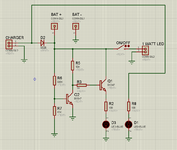gauravkothari23
Advanced Member level 2
Hi All,
I Am trying to make a Battery Charger circuit with Bat LOW Indication using LED (Circuit Attached).
Battery Used: 4V Lead Acid 4 Amp
As per the circuit design, D3 LED glows when battery level goes below 3.4V (Works Perfect)
and D1 LED glows when charger in connected.
but when 5.2V 1.5 Amp charger is connected, D2 Diode SS24, which is connected in series, gets extremely hot even at 1.2 Amps.
Why the diode gets hot even at 1.2 Amps, when it is being rated for 2 Amps.
While charging, i keep the output LED OFF
The Diode D2 is used to to avoid D1 LED glow when charger is not connected.
I Am trying to make a Battery Charger circuit with Bat LOW Indication using LED (Circuit Attached).
Battery Used: 4V Lead Acid 4 Amp
As per the circuit design, D3 LED glows when battery level goes below 3.4V (Works Perfect)
and D1 LED glows when charger in connected.
but when 5.2V 1.5 Amp charger is connected, D2 Diode SS24, which is connected in series, gets extremely hot even at 1.2 Amps.
Why the diode gets hot even at 1.2 Amps, when it is being rated for 2 Amps.
While charging, i keep the output LED OFF
--- Updated ---
The Diode D2 is used to to avoid D1 LED glow when charger is not connected.
Attachments
Last edited:
